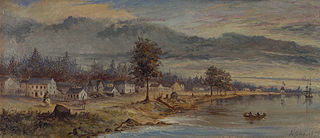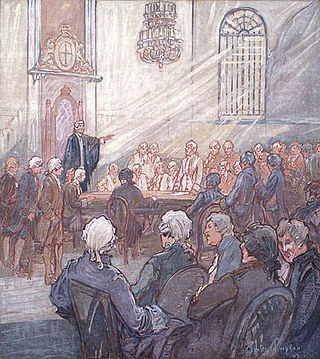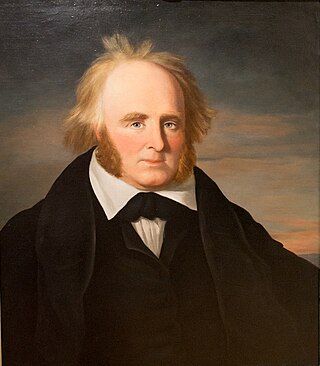
The Province of Upper Canada was a part of British Canada established in 1791 by the Kingdom of Great Britain, to govern the central third of the lands in British North America, formerly part of the Province of Quebec since 1763. Upper Canada included all of modern-day Southern Ontario and all those areas of Northern Ontario in the Pays d'en Haut which had formed part of New France, essentially the watersheds of the Ottawa River or Lakes Huron and Superior, excluding any lands within the watershed of Hudson Bay. The "upper" prefix in the name reflects its geographic position along the Great Lakes, mostly above the headwaters of the Saint Lawrence River, contrasted with Lower Canada to the northeast.

York was a town and second capital of the colony of Upper Canada. It is the predecessor to the old city of Toronto (1834–1998). It was established in 1793 by Lieutenant-Governor John Graves Simcoe as a "temporary" location for the capital of Upper Canada, while he made plans to build a capital near today's London, Ontario. Simcoe renamed the location York after Prince Frederick, Duke of York and Albany, George III's second son. Simcoe gave up his plan to build a capital at London, and York became the permanent capital of Upper Canada on February 1, 1796. That year Simcoe returned to Britain and was temporarily replaced by Peter Russell.

The Family Compact was a small closed group of men who exercised most of the political, economic and judicial power in Upper Canada from the 1810s to the 1840s. It was the Upper Canadian equivalent of the Château Clique in Lower Canada. It was noted for its conservatism and opposition to democracy.

The Canada Company was a private British land development company that was established to aid in the colonization of a large part of Upper Canada. It was incorporated by royal charter on August 19, 1826, under an act of the British parliament, which was given royal assent on June 27, 1825. It was originally formed to acquire and develop Upper Canada's undeveloped clergy reserves and Crown reserves, which the company bought in 1827 for £341,000 ($693,000) from the Province of Upper Canada.

The Province of Quebec was a colony in British North America which comprised the former French colony of Canada. It was established by the Kingdom of Great Britain in 1763, following the conquest of New France by British forces during the Seven Years' War. As part of the Treaty of Paris, France gave up its claim to the colony; it instead negotiated to keep the small profitable island of Guadeloupe.

The Ontario Legislative Building is a structure in central Toronto, Ontario, Canada. It houses the Legislative Assembly of Ontario, and the viceregal suite of the Lieutenant Governor of Ontario and offices for members of the provincial parliament (MPPs). The building is surrounded by Queen's Park, sitting on that part south of Wellesley Street, which is the former site of King's College, which was leased from the university by the municipal government of Toronto in 1859, for a "peppercorn" payment of CAD$1 per annum on a 999-year term. The southern portion of the site was later handed over to the provincial government.

The Legislative Assembly of Upper Canada was the elected part of the legislature for the province of Upper Canada, functioning as the lower house in the Parliament of Upper Canada. Its legislative power was subject to veto by the appointed Lieutenant Governor, Executive Council, and Legislative Council.

Sir William Campbell was Chief Justice of the Supreme Court of Upper Canada and a resident of York, Upper Canada. He also held political appointments in both Nova Scotia and Upper Canada.
The 2nd Parliament of Upper Canada was opened 1 June 1797. Elections in Upper Canada had been held in August 1796. The first session was held at Navy Hall in Newark. The Lieutenant-Governor of Upper Canada John Graves Simcoe believed York was a superior location for the capital as it would less vulnerable to attack by the Americans. York became the capital of Upper Canada on 1 February 1796. The remaining three sessions were held at the Parliament Buildings of Upper Canada in York, Upper Canada. This parliament was dissolved 7 July 1800.
The 6th Parliament of Upper Canada was opened 27 July 1812. Elections in Upper Canada had been held in June 1812. All sessions were held at York, Upper Canada.
The Legislative Assembly of the Province of Canada was the lower house of the Parliament of the Province of Canada. The Province of Canada consisted of the former province of Lower Canada, then known as Canada East, and Upper Canada, then known as Canada West. It was created by The Union Act, 1840.
The Legislative Council of the Province of Canada was the upper house for the Province of Canada, which consisted of the former provinces of Lower Canada, then known as Canada East and later the province of Quebec, and Upper Canada, then known as Canada West and later the province of Ontario. It was created by The Union Act of 1840. With the lower house, the Legislative Assembly of the Province of Canada, the two houses constituted the Parliament of the Province of Canada.

The Legislative Assembly of Lower Canada was the lower house of the bicameral structure of provincial government in Lower Canada until 1838. The legislative assembly was created by the Constitutional Act of 1791. The lower house consisted of elected legislative councilors who created bills to be passed up to the Legislative Council of Lower Canada, whose members were appointed by the governor general.
John Prince, was a lawyer, militia officer, gentleman farmer and political figure in Upper Canada and Canada West.

William Dunlop also known as Tiger Dunlop, was an army officer, surgeon, Canada Company official, author, justice of the peace, militia officer, politician, and office holder. He is notable for his contributions to the War of 1812 in Canada and his work in the Canada Company, helping to develop and populate a large part of Southern Ontario. He was later elected as a Member of Parliament for the Huron riding in the 1st Parliament of the Province of Canada, Canada West.

Sir James Stuart, 1st Baronet of Oxford was a lawyer, judge, and political figure in Lower Canada.
John Robinson Hamilton, QC was a lawyer and political figure in Lower Canada and then the Province of Canada. He represented the electoral district of Bonaventure 1832 to 1834 in the Legislative Assembly of Lower Canada. Following the creation of the Province of Canada, he again represented Bonaventure from 1841 to 1844 in the Legislative Assembly of the Province of Canada. He opposed the union of Lower Canada and Upper Canada into the Province of Canada, and supported the reform movement, which favoured responsible government.

The Parliament of Upper Canada was the legislature for Upper Canada. It was created when the old Province of Quebec was split into Upper Canada and Lower Canada by the Constitutional Act of 1791.
There are currently fourteen legislative buildings in Canada: Parliament in Ottawa, and one for each of the provinces and territories of Canada, though not all contain the words legislative building in their names.

Formally known as "His Majesty's Council of Nova Scotia", the Nova Scotia Council (1720–1838) was the original British administrative, legislative and judicial body in Nova Scotia. The Nova Scotia Council was also known as the Annapolis Council and the Halifax Council. After 1749, when the judicial courts were established, the Nova Scotia Council was limited to administrative and legislative powers.












